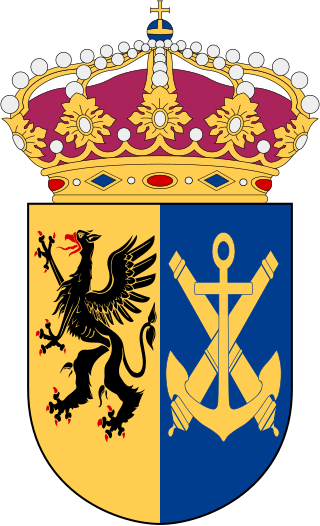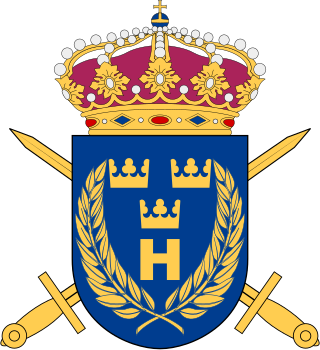
The Skaraborg Regiment, designation P 4, is a Swedish Army armoured regiment that traces its origins back to the 16th century. It was converted from an infantry regiment in 1942. The regiment's soldiers were originally recruited from Skaraborg County, and it is currently garrisoned in Skövde, in the former Skaraborg County.

The Småland Regiment, designations I 12 and I 12/Fo 17, was a Swedish Army infantry regiment that traced its origins back to the 16th century. The unit was disbanded as a result of the disarmament policies set forward in the Defence Act of 2000.

The Chief of Army is the most senior appointment in the Swedish Army. The position Chief of Army was introduced in 1937 and the current form in 2014.
The Defence Staff is the Supreme Commander of the Swedish Armed Forces' staff body and command resource for military strategic command, mission dialogue and reporting to the Swedish government, as well as being responsible for the war organization's capability, availability and combat readiness. The latter with the support of the service branch commanders and the service branch staffs.

The Western Army Division, was a division of the Swedish Army that operated in various forms from 1941 to 1997. Its staff was located in Skövde Garrison in Skövde.

Maritime Component Command was a part of the Joint Forces Command of the Swedish Armed Forces. The staff was located at the Swedish Armed Forces Headquarters in Stockholm and is headed by the Chief of Navy. The Maritime Component Command commanded the operations of the Swedish Navy forces.

The Swedish Naval Warfare Centre is a joint naval school of the Swedish Navy which has been operating since 2005. The unit is based in Karlskrona Garrison in Karlskrona.

Södertörn Marine Regiment (Swedish: Södertörns marinregemente, designation SMR, was a Swedish Navy coastal artillery unit which operated from 1956 to 2000. The unit was based on Järflotta south of Nynäshamn.
Norrbotten Artillery Corps, designation A 5, was a Swedish Army artillery unit which operated between 1928 and 1951. The unit was based in Boden Garrison in Boden, Sweden.
Uppland Artillery Regiment, designation A 5, was a Swedish Army artillery unit which operated between 1894 and 1927. The unit was based in Uppsala Garrison in Uppsala, Sweden.

The Småland Artillery Regiment, designation A 6, was a Swedish Army artillery regiment raised in 1895. It was disbanded in 1985. The regiment was based in Jönköping.

The Härnösand Coastal Artillery Regiment, designation KA 5, was a Swedish Navy coastal artillery regiment of the Swedish Armed Forces which operated between 1943 and 1998. The unit was based in Härnösand.
The Northern Military Region is a Swedish military region within the Swedish Armed Forces. Established in 2013, the military region staff in based in Boden Garrison. The military region includes Norrbotten County, Västerbotten County, Jämtland County and Västernorrland County.
The Western Military Region is a Swedish military region within the Swedish Armed Forces. Established in 2013, the military region staff in based in Skövde. The military region includes Halland County, Värmland County, Västra Götaland County and Örebro County.

The National Home Guard Combat School is a school of the Swedish Home Guard which trains Home Guard commanders in combat and leadership. Its based in Vällinge in Salem Municipality.

The Naval Base is a naval unit within the Swedish Navy that has operated in various forms since 1928. The unit is mainly based within Karlskrona naval base in Karlskrona and but operations are also conducted at Berga Naval Base and Muskö Naval Base outside Stockholm and in Gothenburg.
The Central Military District was a military district within the Swedish Armed Forces from 2000 to 2005. Its staff was located in Strängnäs, Sweden. The military district included Stockholm, Uppsala, Södermanland, Östergötland, Värmland, Örebro, Västmanland, Dalarna and Gävleborg counties.
The Central Air Command was an air command within the Swedish Air Force that operated from 1994 to 2000. The unit was based in Bålsta in Uppsala Garrison. It was responsible for air surveillance over Central Sweden.
The Northern Air Command was an air command within the Swedish Air Force that operated from 1994 to 2000. The unit was based in Luleå in Luleå Garrison. It was responsible for air surveillance over northern Sweden.
The Southern Air Command was an air command within the Swedish Air Force that operated from 1994 to 2000. The unit was based in Ängelholm. It was responsible for air surveillance over South Sweden.













